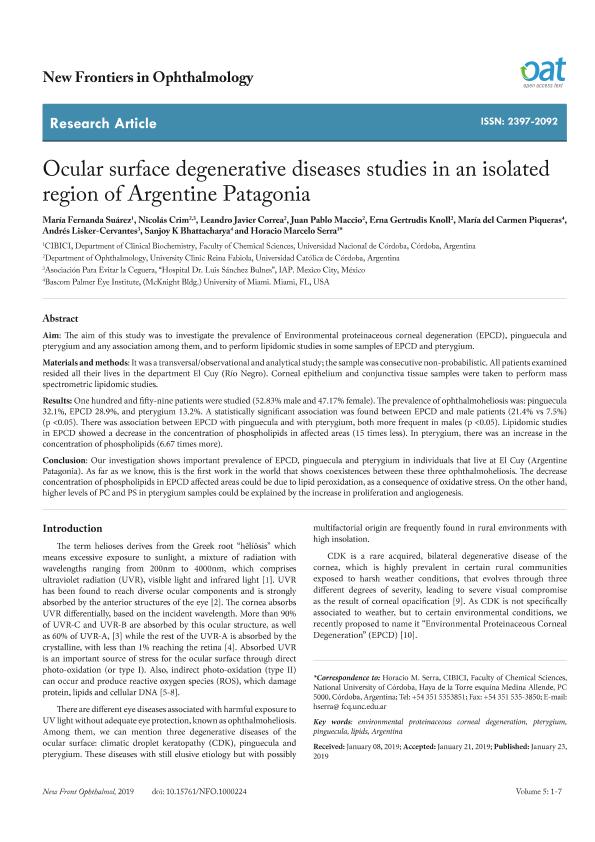Artículo
Ocular surface degenerative diseases studies in an isolated region of Argentine Patagonia
Suarez, Maria Fernanda ; Crim, Nicolás; Correa, Leandro; Maccio, Juan Pablo; Knoll, Erna G.; Piqueras, Carmen; Bhattacharya, S. K.; Serra, Horacio Marcelo
; Crim, Nicolás; Correa, Leandro; Maccio, Juan Pablo; Knoll, Erna G.; Piqueras, Carmen; Bhattacharya, S. K.; Serra, Horacio Marcelo
 ; Crim, Nicolás; Correa, Leandro; Maccio, Juan Pablo; Knoll, Erna G.; Piqueras, Carmen; Bhattacharya, S. K.; Serra, Horacio Marcelo
; Crim, Nicolás; Correa, Leandro; Maccio, Juan Pablo; Knoll, Erna G.; Piqueras, Carmen; Bhattacharya, S. K.; Serra, Horacio Marcelo
Fecha de publicación:
07/2019
Editorial:
OAT
Revista:
New Frontiers in Ophthalmology
e-ISSN:
2397-2092
Idioma:
Inglés
Tipo de recurso:
Artículo publicado
Clasificación temática:
Resumen
The aim of this study was to investigate the prevalence of Environmental proteinaceous corneal degeneration (EPCD), pinguecula andpterygium and any association among them, and to perform lipidomic studies in some samples of EPCD and pterygium.Materials and methods: It was a transversal/observational and analytical study; the sample was consecutive non-probabilistic. All patients examine dresided all their lives in the department El Cuy (Río Negro). Corneal epithelium and conjunctiva tissue samples were taken to perform massspectrometric lipidomic studies.Results: One hundred and fifty-nine patients were studied (52.83% male and 47.17% female). The prevalence of ophthalmoheliosis was: pinguecula32.1%, EPCD 28.9%, and pterygium 13.2%. A statistically significant association was found between EPCD and male patients (21.4% vs 7.5%)(p <0.05). There was association between EPCD with pinguecula and with pterygium, both more frequent in males (p <0.05). Lipidomic studiesin EPCD showed a decrease in the concentration of phospholipids in affected areas (15 times less). In pterygium, there was an increase in theconcentration of phospholipids (6.67 times more).Conclusion: Our investigation shows important prevalence of EPCD, pinguecula and pterygium in individuals that live at El Cuy (ArgentinePatagonia). As far as we know, this is the first work in the world that shows coexistences between these three ophthalmoheliosis. The decreaseconcentration of phospholipids in EPCD affected areas could be due to lipid peroxidation, as a consequence of oxidative stress. On the other hand,higher levels of PC and PS in pterygium samples could be explained by the increase in proliferation and angiogenesis.
Archivos asociados
Licencia
Identificadores
Colecciones
Articulos(CIBICI)
Articulos de CENTRO DE INV.EN BIOQUI.CLINICA E INMUNOLOGIA
Articulos de CENTRO DE INV.EN BIOQUI.CLINICA E INMUNOLOGIA
Citación
Suarez, Maria Fernanda; Crim, Nicolás; Correa, Leandro; Maccio, Juan Pablo; Knoll, Erna G.; et al.; Ocular surface degenerative diseases studies in an isolated region of Argentine Patagonia; OAT; New Frontiers in Ophthalmology; 5; 7-2019; 1-7
Compartir
Altmétricas



